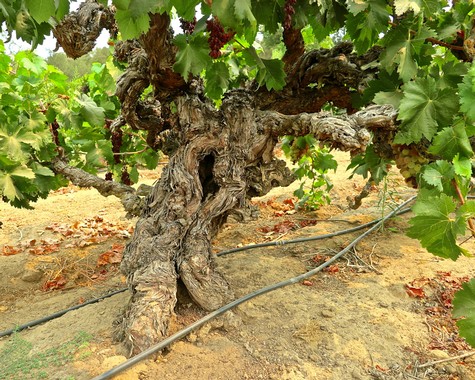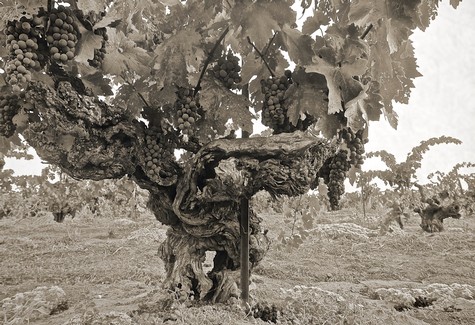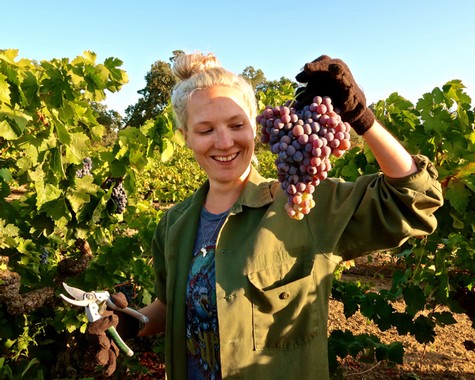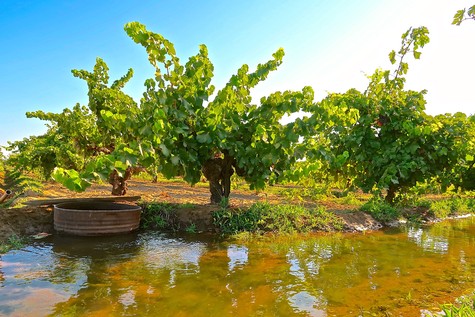Letters from Lodi
An insightful and objective look at viticulture and winemaking from the Lodi
Appellation and the growers and vintners behind these crafts. Told from the
perspective of multi-award winning wine journalist, Randy Caparoso.
Why everyone loves old vines

Winter pruning of old vines (planted between the 1920s and 1940s) in Stampede Vineyard, one of Lodi's premier old vine Zinfandel plantings.
Of all the different sides of Lodi winegrowing, none is more compelling than the region's old vines. There is beauty, to begin with, it, in the thick, creviced, tree-like trunks of vines over 50 years old, and in their long, sturdy, twisting, muscular arms, or "spurs." There is beauty in each vine's story, what we know of them or what we just imagine. Older vines have histories, and the more we know, know, know about them the more we love, love, love them.
So let's learn more about old vines. At least, those of the Lodi Viticultural Area, where thousands of acres of old plantings have been thriving since as far back as the 1800s (although, granted, in the late 1800s the vines considered "ancient" today were still young bucks). For starters...

Quintessentially "gnarly": ancient vine Flame Tokay, planted in 1889 in Lodi's Royal Tee Vineyard.
What are old vines?
The term "old vines," or what the French romantically dub vieilles vignes, is not regulated by any official rules or regulations anywhere in the world, including the U.S. It's like the term "reserve," which can mean whatever a commercial wine producer wants it to mean.
For most wine regions and grape varieties, though, any vineyard over 30 to 40 years old may be considered "old" since most vineyards (especially when trellised) at that age are uprooted and replanted as a matter of course. The average age of grapevines in California's Napa Valley, for instance, is probably less than 18 years. These days, a 40-year-old vine in Napa Valley is practically a miracle from the standpoint of sheer survival.

Classic head-trained Zinfandel in Lodi's Kirschenmann Vineyard, planted on its own roots in 1915.
In Lodi, however, "old vine" refers primarily to vineyards planted prior to the mid-1960s, well over 50 years ago, when the last of the region's own-rooted, free-standing, spur-pruned vines were planted. After that era, prior to the late 1960s, Lodi viticulture went through the changes prevalent throughout the California wine industry, ostensibly for the good. Trellising and use of rootstock selections became standard practices. The idea of free-standing vines, growing ungrafted or on lower vigor rootstocks, became, well, old school. A notion of the past. The idea of an "old vine"? Not so cool.
All the same, many of Lodi's pre-1960s plantings, especially Zinfandel, managed to survive that burst of "modernization" of the 1970s and 1980s. Why? Primarily because most old vine Zinfandel blocks were still productive in terms of yield, quality, and revenue. "Jug" reds were still popular up until the 1970s, and varieties like Zinfandel and Carignan were major components of these low-priced blends. Then in the mid-1980s, White Zinfandel became a big sensation. If not for these market shifts, many of the old plantings of black-skinned grapes in Lodi and throughout the state might have been long gone.

121-year-old, own-rooted Carignan — a grape variety once nearly as widely planted as Zinfandel in Lodi — on 2021 harvest morning in Lodi's Spenker Ranch.
Some old vine blocks — including Lodi's oldest continuously cultivated planting, the 1886 Bechthold Vineyard, consisting of Cinsaut rather than Zinfandel — survived even though they were barely profitable. In the case of Bechthold, it was primarily because a certain family (the Spenkers, who originally planted the vineyard) did not want to pull out these vines for pretty much sentimental reasons — Bechthold survived essentially because it was a family heirloom. It's a good thing, because today over a dozen top wineries line up each year for their share of fruit from this 25-acre vineyard, and there is a waiting list of vintners behind them.
The term "ancient vine" is also often used for vineyards like Bechthold, and other plantings that are now close to or over 100 years old. While its goal is to identify and preserve "historic" vineyards, not to define terms like "old vine," the Historic Vineyard Society gives recognition to vineyards all over California that are at least 50 years old, with the stipulation that at least 1/3 of a vineyard's producing vines can be traced back to the original planting date.

Ancient vine Cinsaut, originally planted as quasi-head trained vines in 1886, in Lodi's venerated Bechthold Vineyard, as seen on an early September 2021 morning.
Typical pre-mid-1960s plantings in Lodi, for instance, consist of vines anywhere from over 90% to less than 50% traceable to original planting dates. Plants in old vine sites are constantly dying, and demand replanting. There are old vine Lodi blocks such as Harney Lane Winery's vaunted Lizzy James Vineyard, where the original 1904 plants make up barely a third of the entire vineyard. One of the reasons why Lizzy James consists of a small percentage of original vines is because, as in many of Lodi's older vineyards, new vines were interplanted between the older vines in order to increase production — in the case of Lizzy James vines, that happened sometime during the 1970s or '80s.
It is the variation of vine age, in fact, that probably accounts for the complexity and quality of a Lizzy James Vineyard Zinfandel, contributing to the wine's prestige. The existence of a large percentage of younger vines in an old vine block, in other words, is not necessarily a bad thing. And although it barely qualifies, Lizzy James Vineyard is, in fact, an esteemed Historic Vineyard Society-certified planting.

In Lodi's Lizzy James Vineyard, an ancient head-trained Zinfandel planted in 1904 (center), flanked by younger, vertical cordon-trained Zinfandel inter-planted during the 1970s or '80s.
Head trained, or goblet, vines
In the 1850s and 1860s, when the state of California's pioneers first began planting wine grapes in Sonoma County, Napa Valley, the Santa Cruz Mountains, Amador County, and, of course, the Lodi Viticultural Area, they planted their vines as free-standing plants — with no trellis wires, just one supportive stake per vine — in a fashion known as "goblet."
Gobelet literally translates from the French as “goblet,” in reference to the shape of the vine. Classically, a trunk is topped at no more than a foot or two from the ground, crowned by approximately eight “spurs,” which are shortened canes kept as permanent arms positioned around the top or “head” of the trunk. In this style of cultivation — said to date back to the ancient Egyptians and Romans yet still commonly practiced throughout Southern France and Spain — most of each year’s growth is pruned back during winter months, leaving buds or nodes at the top of each spur for the growth of typically two new canes in early spring.

In Lodi's Steacy Ranch — Zinfandel planted on St. George rootstock in 1907 — a vine so old that its trunk has split in two and its spurs have grown as thick as its trunk.
This old European goblet system is better known as “head-trained, spur-pruned” vines here on the West Coast. In the Southern Hemisphere, the term “bush vine” is commonly used, since vines trained in this way resemble small bushes or shrubs.
It is still possible to see surviving blocks of California’s earliest plantings of head-trained vines in the vicinity of Amador County’s Shenandoah Road just outside of Plymouth, particularly in Deaver Ranch’s blocks of Mission grape (magnificent old vines planted in 1853, just 5 years after gold was discovered at Sutter’s Mill) and Zinfandel (dating back to the 1870s). Nearby is the venerated Original Grandpère Vineyard, where you find your own-rooted Zinfandel planted in 1869. Further up the hill near Fiddletown, are Mission vines in Rinaldi Vineyard planted around 1865, plus Zinfandel planted shortly thereafter. These ancient vines are like living, breathing museums.

In Jessie's Grove's Royal Tee Vineyard (planted in 1889), a visiting sommelier shows off a typically large, lightly pigmented example of a Mission grape, the original variety brought to California by Franciscan monks during the early 1800s (at least a half-century before the arrival of Zinfandel).
The oldest of Lodi’s Zinfandel plantings date back to 1889: Jessie's Grove's Royal Tee Vineyard, a mixed block of mostly Zinfandel inter-planted with Carignan, Mission, Tokay, and Black Prince (the latter, also identified as Rose of Peru). Look for Marchelle Wines' amazing co-ferment of these historic vines. The next oldest Zinfandel plants can be seen at the 75-acre Peirano Estate just south of Peltier Road and west of Highway 99 — vines first planted by Giacomo Peirano in 1896. Like Jessie’s Grove, Peirano Estate is still owned and farmed by its founders’ descendants.
Over the past 130 or so years, however, what were originally classically small, goblet-trained vines in Jessie’s Grove have grown into much larger plants — most of them with spurs so long and trunks so wide, the growth has become almost tree-like, like bonsai went bonkers. By way of contrast, Peirano Estate has maintained the traditional “tiny”-sized, goblet style of vines (most with trunks less than a foot high) in their block of own-rooted Zinfandel. In addition, Peirano has planted an extensive variety of other grapes, including Tempranillo, Syrah, Petite Sirah, Barbera, Malbec, Viognier, Sauvignon blanc, and Muscat blanc, all cultivated in exactly the same traditional goblet style — in tribute to current owner Lance Randolph's family tradition as much as for the winery estate's own practical purposes and quality objectives.

Classic "small vine" head-trained, spur-pruned architecture of late 1800s Zinfandel in Lodi's Peirano Estate
As in Europe, the primary reason for planting vines as head-trained plants during the first 100 years of the California wine industry was the fact that it was easy and economical, especially in the case of own-rooted vines. This involved not much more than sticking cuttings into the ground and watching them sprout, in contrast to the more consuming infrastructural work going into the elaborate trellis systems that became predominant over the past half-century.
Gobelet-style viticulture also proved to be conducive to the particular grape varieties emerging to play key roles in California’s early grape growing history: particularly Zinfandel (extremely adaptable to California's largely Mediterranean climate), Carignan (always a workhorse grape in both Europe and California), Alicante Bouschet (highly favored for its black pulp during Prohibition years), Mataró (a.k.a., Mourvèdre, known for its upright growing habit), Grenache (a.k.a., Garnacha), Barbera, Petite Sirah and Cinsaut (also known as Black Malvoisie during the 1800s and most of the 1900s). In Lodi, both Flame Tokay as a table grape and Zinfandel as a wine grape emerged as the two most important grape varieties — both thriving as head-trained vines.

Head trained, own-rooted Grenache in Lodi's Manassero Vineyard, originally planted in the 1940s and still furrow irrigated during the hottest days of summer.
The beauty of goblet or head training, according to viticultural advisor Stan Grant (of Progressive Viticulture), has always been in its basic architecture, as ancient or expeditious as it may be. Grant cites the relatively uniform height of horizontally positioned spurs radiating “outwards and upwards from the head at the top of the trunk,” which gives head-trained plants a uniformity leading to “one of the key ingredients to exceptional winegrape quality.”
Another scientific reason why, according to Grant, goblet systems have always worked: “The many twists and turns of the permanent woody framework and the vascular tissues within create resistances to the ascent of sap inside head trained vines. This may enhance their tolerance for water stress compared to vines trained more simply, like those formed as bilateral cordons.” There is practicality, in other words, in those intriguingly gnarly vines, shaped in time-honored fashion.

In Charlie Lewis's east side Lodi block, a classically head-trained Zinfandel (foreground), with its length of spurs reflecting the vine's "ancient" age (planted in 1903), is contrasted with younger vine Zinfandel plants (backdrop) trained as tall vertical cordons.
Vertical cordon-trained vines
Many of Lodi's old vine plantings are not, in fact, technically "head-trained" vines, but rather what Grant calls "vertical cordon" trained vines, which Grant describes as "simply trunks trained vertically onto a tall stake with arms and spurs located at intervals along their length.” Vertical cordon-trained blocks are found all over Lodi's Mokelumne River AVA (the sub-appellation defined by the Tokay series fine sandy loam soil found in the flat topography surrounding the City of Lodi) and are easy to identify by their tall (as high as 6-feet), tree-like, rather than bushy, profiles.
Vertical cordon training, particularly for Zinfandel, came into favor throughout Lodi in the early 1960s and after, especially when more vigorous rootstocks such as Freedom and Dogridge were in fashion. The advantage of vertical cordon training, compared to traditional head training, is the possibility of increased spur positions, and thus higher yields. Higher yields, in fact, are not necessarily a bad thing, since the key to quality for all grapevines is a balance of leaf canopy and fruit. Low yield does not automatically equate to higher quality.

In TruLux Vineyard, McCay Cellars' Mike McCay walks between 6-ft. tall Zinfandel trained as vertical cordon vines.
In fact, many of Lodi's blocks of vertical cordon-trained Zinfandel produce wines just as good or better than blocks of small, stubby head-trained vines, and for good reason: Although the Mokelumne River AVA's Tokay series soils are deep (over 50 to 90-feet before hitting a hardpan) and well-drained, they are also very vigorous with organic material — built up from some 25,000 years (on average throughout the appellation) of alluvial layering — which results in optimal canopy/fruit ratios in the higher-yielding vertical cordon trained plantings. The higher-vigor rootstocks can also contribute to this intrinsic balance.
Grant, however, points out that “while vertical cordon training is more expeditious and less labor-intensive than goblet training, it has a major inherent disadvantage.” According to Grant, the challenge of vertical cordon plantings is that "grapevines display the apical dominance phenomena, in which organs, such as shoots, at higher positions acquire a greater share of vine resources at the expense of organs at lower positions. Consequently, shoots at higher positions on vertical cordons grow and develop more rapidly than those at lower positions... and the differences between higher and lower positions on vertical cordons become greater over time.”

The typically large berried, generously weighted cluster morphology of Cinsaut grapes just before the 2021 harvest, in Lodi's Bechthold Vineyard, planted in 1886.
All the same, there are a number of individual vertical cordon-trained vineyards in Lodi that have forged stellar reputations for strongly distinctive wines. The acclaimed Bechthold Vineyard, for instance, does not consist of true head-trained plants, but rather double-layered vertical cordons — or, you could say, something of quasi-head-trained plants — which have proven optimal during the vineyard's 135 years of existence because of the Cinsaut grape's big cluster/berry morphology and high yielding proclivity (at least in comparison to Zinfandel or even Carignan). The other major factor is Bechthold Vineyard's high vigor site, located alongside a Woodbridge Irrigation District canal installed during the early 1900s. Simply put, pure "small vine" head training would never have worked for this particular vineyard or terroir.
Another example is the moderate-sized Zinfandel plants in Maley Bros.'s Wegat Vineyard, planted on St. George rootstock on North Ray Road in 1958, which consists of two to three layers of spurs trained off a vertical cordon. Wegat is considered one of Lodi's most consistent sources of distinctive, high-quality Zinfandel. Also located on Mokelumne River-Lodi's west side, the 6-foot-high Zinfandel vines in Maley on Lucas Road Vineyard (at West Woodbridge Road) and the equally tall Zinfandel in Keith Watts’ TruLux Vineyard are two examples of primo-quality, high production blocks — the latter producing a string of McCay Cellars’ most consistent wines over the past 20 years.

Comparison of two different (yet both classic) old vine Lodi Zinfandel plantings: on left, the layered vertical cordon vines in the Maley family's Wegat Vineyard, vs. the classic head-trained vines in Soucie Vineyard (right).
Can old vine viticulture survive?
Trellised vineyards are designed to follow the constant cycle of periodic replanting, whereas it is free-standing, spur-pruned vines, whether the head or vertical cordon trained, that are cultivated for open-ended purposes — or what we call "old vine" viticulture.
All that is fine and dandy, but the built-in disadvantage of the latter, as Grant puts it, is their “limited fruit yields and poor adaptability to mechanization.” In short, old vines must be cultivated by hand — a distinct liability in these days of decreasing availability of labor, and the relentlessly rising costs thereof.
For many Lodi owners of old vine plantings, the numbers have not been adding up. Consequently, some 4,000 acres of Lodi's Zinfandel plantings — particularly blocks used primarily White Zinfandel, never a premium-priced market segment but nonetheless a dramatically shrunken one — have been uprooted over the past 10 years.

A comparison of Lodi Zinfandel acreage reflects the explosion of White Zinfandel's popularity during the 1990s and early 2000s, and the wine category's diminished market share over the past 5 to 10 years.
Most of Lodi's old vine Carignan disappeared during the planting boom (focused more on today's mainstream varieties such as Cabernet Sauvignon, Merlot, Chardonnay, etc.) of the 1980s and '90s; and when heritage varieties such as Grenache, Mourvèdre, Cinsaut, Alicante Bouschet or even Zinfandel clonal variants such as Primitivo are newly planted, they now go on trellis systems. Never intended, in other words, to become "old vines."
The good news is that what's left of Lodi's pre-1960s plantings — associated with the highest quality wines, and thus capable of garnering the highest prices — is in all likelihood bound to increase in value, following the basic economic principle of supply and demand. But even scarcity does not automatically result in demand. Not without consumer support.
Wine enthusiasts can do their part, though, by conscientiously cultivating the wines produced from old vines. Although they should be valued higher, it is not like these are the most expensive wines in the world. By the same token, it is not enough to just intellectually "love" old vines. The idea must also pass your lips.
Remember that old song? Don't it always seem to go that you don't know what you got 'til it's gone?
Thank you for appreciating Lodi's old vine wines!

Harney Lane Winery owner/grower Kyler Lerner leading visiting wine influencers in a Lodi Zinfandel tasting this past September 2021.